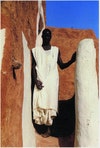Susannah Clapp is a literary and theatre critic as well as a founder of the London Review of Books. Back in the 1970s, she was
The house of Pisé, in Mali.
Chatwin wasn’t exactly new to writing. “There was a huge manuscript about nomadism that he had been working on years before, but he had never given it any shape,” says Clapp. “He never saw himself as an author, rather as a journalist, as well as an art expert, of course.” And luckily (for Clapp and our readers), “he loved editing and had no problem with chucking out entire chapters. The next day he’d come back with a new one he had written overnight. He had a quick, terse style, honed by writing endless entries for art catalogues.” He was young when he showed up at Clapp’s office, but he already had a past. At Sotheby’s, where he started work at 18, “he was a star. He had a sharp eye for fakes, and an equally keen eye for everything that was good and genuine. He was also capable of charming clients into buying or selling.” Then there was his legendary visit to Somerset Maugham on the French Riviera, “to catalogue the writer’s collection of Impressionists”. Maugham particularly loved playing with his yellow hair. (“His bosses at Sotheby’s warned him what to expect and told him to be sure to shampoo it,” wrote Clapp in her account of their collaboration and friendship, With Chatwin: Portrait of a Writer, published by Vintage.) He was ready to try anything, but he also got bored quickly. “He threw up his job at the auction house to go to the University of Edinburgh and study archaeology. But he left after two years without a degree.” At 30, he was taken on at The Sunday Times Magazine where he wrote profiles such as the one on his idol Ernst Jünger. Chatwin wooed him (for he was above all an exceptional suitor) with the invitation: “Dear Herr Jünger, The Sunday Times has a tradition of conducting interviews with great Europeans – I personally just did André Malraux in Paris. My German is rudimentary, but I know your French is splendid. May I have the honour of interviewing you?” Jünger naturally fell for it, and the piece opened with some striking words: “We have before us a man in the midst of the occupation of Paris with bombers flying overhead as he stands on a rooftop hobnobbing with a glass of champagne in his hand.”
Maria Reiche, German mathematician and geographer who dedicated her life to the study of the Nazca Lines in the Pampa de Ingenio.
One may debate whether or not Chatwin was a great writer, but he certainly invented a concise, spare and delectable style that has aged well. “His models were Byron, Flaubert, Hemingway and Noël Coward,” says Clapp. He was definitely a functionalist. Anything that could be cut from the page was promptly eliminated. “You could see it in the pieces he had in his apartment. They weren’t necessarily paintings but curios with a story – extraordinary artefacts that all had some special purpose. For example, there was a tray used by fishermen in Istanbul to lay out their catch.” Does Chatwin have any successors? “He has inspired many, but I don’t know. No, and I really don’t care,” says Clapp, perhaps with nostalgia.
It was thanks to Eileen Gray that Chatwin went to Patagonia (where a statue should be erected to him, although nowadays it would immediately risk being pulled down). She was another of his heroines who shared his aversion to decoration. The elderly Irish furniture designer was living on Rue Bonaparte in Paris, and had a gouache map of Patagonia hanging in her living room. “I’ve always wanted to go there,” remarked Chatwin. “So have I,” replied Gray. “Go there for me.” He went, telegraphing news of his departure to The Times: “Have gone to Patagonia.”
“In Patagonia redefined the idea of a travel book. It was filled with fragments telling of encounters, personal stories and recollections, all apparently unrelated to each other. It was a kind of cubist book, an expression that Bruce liked a lot,” says Clapp. She also helped Chatwin with his second book (The Viceroy of Ouidah) and his final novel, Utz, “which he wrote when he was dying”.
(Continues)
Opening photograph: Bruce Chatwin in Hindu Kush, in 1964.
All the images: photographs by Bruce Chatwin and David Nash, from the book L’occhio assoluto - Fotografie e taccuini, Adelphi/by Bruce Chatwin (“Bruce Chatwin: Photographs and Notebooks”, first English edition published by Jonathan Cape). Courtesy of Bruce Chatwin Estate and Adelphi Edizioni.

